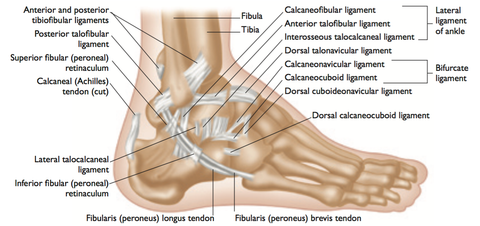Trigger Point Therapy - Ankle Sprains
Treating Ankle Pain and Instability
Anyone involved in athletics is particularly susceptible to an ankle sprain - an acute injury to any or all of the ligaments that support the ankle structure.
Tearing or stretching of the ligaments can occur when the foot is rolled or twisted forcefully.
High-impact sports involving jumping, sprinting or running on changing or uneven surfaces often lead to ankle sprains.
Basketball, football, cross country and hockey are a few of the sports commonly associated with ankle sprains.
Lateral ankle or inversion sprains commonly occur when stress is applied to the ankle during plantarflexion.
The anterior talofibular ligament is most commonly injured. The medial malleolus may act as a fulcrum to further injure the calcaneofibular ligament if the strain continues.
The peroneal tendons may absorb some of this strain. Medial ankle sprains are less common because of the strong deltoid ligament and bony structure of the ankle.
When ligaments are stretched beyond their normal range some tearing of the fibres may occur.

Cause of Injury
Sudden twisting of the foot. Rolling or force to the foot, most commonly laterally.
Signs and Symptoms
First-degree sprains: Little or no swelling; mild pain and stiffness in the joint.
Second-degree sprains: Moderate swelling and stiffness; moderate to severe pain; difficulty weightbearing and some instability in the joint.
Third-degree sprains: Severe swelling and pain; inability to weightbear; instability and loss of function in the joint.
Complications if Left Unattended
Chronic pain and instability in the ankle joint may result if left unattended. Loss of strength and flexibility and possible loss of function may also result. Increased risk of re-injury.
Immediate Treatment
RICER. Second- and third-degree sprains may require immobilization and immediate medical attention should be sought.
Rehabilitation and Prevention
Strengthening the muscles of the lower leg is important to prevent future sprains. Balance training will help to improve proprioception (the body’s awareness of movement and joint position sense) and strengthen the weakened ligaments.
Flexibility exercises to reduce stiffness and improve mobility are needed also. Bracing during the initial return to activity may be needed but should not replace strengthening and flexibility development.
Long-Term Prognosis
With proper rehabilitation and strengthening the athlete should not experience any limitations. A slight increase in the probability of injuring that ankle may occur.
Athletes who continue to experience difficulty with the ankle may need additional medical interventions including, in rare cases, possible surgery to tighten the ligaments.
Trigger Points
Foot pain, ankle pain, and ankle instability are typically associated with trigger points in balancing muscles. These trigger points need to be located and treated to prevent injury recurrence.
Self Help
Stretching can often provide some temporary relief from ankle pain, and possibly help to treat some trigger points over time.
This is not something that's proven, but the anecdotal evidence in considerable, and some would say overwhelming.
The most common trigger point related to ankle pain is the one that forms in the tibialis anterior muscle.
The following stretch might provide relief by helping to dissipate the trigger point and aid rehabilitation.

Technique
Stand upright and place the top of your toes on the ground behind you. Push your ankle to the ground.
Muscles Being Stretched
Primary muscle: Tibialis anterior.
Secondary muscles: Extensor hallucis longus. Extensor digitorum longus. Peroneus tertius.
Injury Where Stretch May Be Useful
Ankle Pain. Ankle Weakness. Ankle Instability. Anterior compartment syndrome. Medial tibial pain syndrome (shin splints). Ankle sprain. Peroneal tendon subluxation. Peroneal tendonitis.
Additional Notes for Performing This Stretch Correctly
Regulate the intensity of this stretch by lowering your body and pushing your ankle to the ground. If need be, hold onto something for balance.
This blog is intended to be used for information purposes only and is not intended to be used for medical diagnosis or treatment or to substitute for a medical diagnosis and/or treatment rendered or prescribed by a physician or competent healthcare professional. This information is designed as educational material, but should not be taken as a recommendation for treatment of any particular person or patient. Always consult your physician if you think you need treatment or if you feel unwell.
About Niel Asher Education
Niel Asher Education (NAT Global Campus) is a globally recognised provider of high-quality professional learning for hands-on health and movement practitioners. Through an extensive catalogue of expert-led online courses, NAT delivers continuing education for massage therapists, supporting both newly qualified and highly experienced professionals with practical, clinically relevant training designed for real-world practice.
Beyond massage therapy, Niel Asher Education offers comprehensive continuing education for physical therapists, continuing education for athletic trainers, continuing education for chiropractors, and continuing education for rehabilitation professionals working across a wide range of clinical, sports, and wellness environments. Courses span manual therapy, movement, rehabilitation, pain management, integrative therapies, and practitioner self-care, with content presented by respected educators and clinicians from around the world.
Known for its high production values and practitioner-focused approach, Niel Asher Education emphasises clarity, practical application, and professional integrity. Its online learning model allows practitioners to study at their own pace while earning recognised certificates and maintaining ongoing professional development requirements, making continuing education accessible regardless of location or schedule.
Through partnerships with leading educational platforms and organisations worldwide, Niel Asher Education continues to expand access to trusted, high-quality continuing education for massage therapists, continuing education for physical therapists, continuing education for athletic trainers, continuing education for chiropractors, and continuing education for rehabilitation professionals, supporting lifelong learning and professional excellence across the global therapy community.

Continuing Professional Education
Looking for Massage Therapy CEUs, PT and ATC continuing education, chiropractic CE, or advanced manual therapy training? Explore our evidence-based online courses designed for hands-on professionals.


















